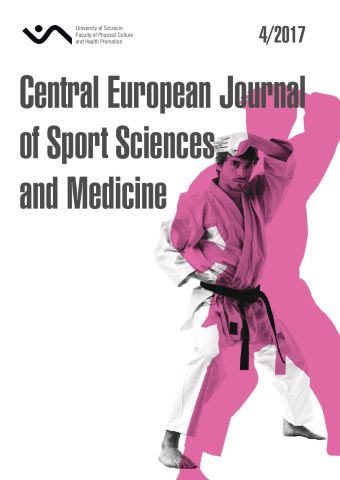
ISSN: 2300-9705
eISSN: 2353-2807
OAI
DOI: 10.18276/cej.2017.4-04




Lista wydań /
Vol. 20, No. 4/2017
The Influence of the 6-month Course of Nordic Walking on Patient with Parkinson's Disease - a Case Report
| Autorzy: |
Paula
Musiał
Student Scientific, Department of Kinesiology, Department of Physiotherapy, Faculty of Health Sciences, Medical University of Silesia in Katowice Monika Michalik Student Scientific, Department of Sports Medicine and Exercise Physiology, Faculty of Health Sciences, Medical University of Silesia in Katowice Ewelina Nowak Student Scientific, Department of Sports Medicine and Exercise Physiology, Faculty of Health Sciences, Medical University of Silesia in Katowice Justyna Szefler-Derela School of Health Sciences in Katowice, Medical University of Silesia, Department of Physiotherapy, Chair of Physiotherapy, Katowice, Poland |
| Słowa kluczowe: | Physiotherapy Parkinson's disease Nordic Walking |
| Data publikacji całości: | 2017 |
| Liczba stron: | 8 (31-38) |
Abstrakt
A person with Parkinson's disease has bigger problems with maintaining the stability than the healthy person. Nordic Walking is a safe kind of physical activity for elderly people.
The aim of this study is to present the influence of a 6-month therapy of the Nordic Walking on the imbalance and the risk of falls for 66-years-old patient with Parkinson's disease.
On the basis of results of 4 tests, performed both at the beginning and at the end of the Nordic Walking therapy, we have made a comparison of patient’s changes before and after 6 months of rehabilitation.
the DGI test, the PD patient received 18 points. After he got 22 points. In the Functional Reach Test ( FR), while attempting to reach forward, reached out for 23 cm before the therapy, and 31 cm after the therapy. In the test and go up the patient got a time of 63 seconds, after therapy the time was reduced to 45 s.
Nordic Walking is a safe kind of physical activity for people with Parkinson's disease. It reduces muscle tension, and improves joint function.
Pobierz plik
Plik artykułu
Bibliografia
| 1. | Behrman, A. (2002). Is the functional reach test useful for identifying falls risk among individuals with Parkinson’s disease? Physical Medicine and Rehabilitation, 4, 538–542. |
| 2. | Chęcińska-Hyra, O. (2012). Ocena sprawności kończyn górnych osób z chorobą Parkinsona uprawiających Nordic Walking. Rozprawy Naukowe, 39, 110–112. |
| 3. | De Dreu, M., Van der Wilk, A., Poppe, E., Kwakkel, G., Van Wegen, E. (2012). Rehabilitation, exercise therapy and music in patients with Parkinson’s disease: a meta-analysis of the effects of music-based movement therapy on walking ability, balance and quality of life. Parkinsonism & Related Disorders, 18, 114–119. |
| 4. | Dyszkiewicz, A. (2006). Znaczenie posturometrii i stabilografii w rehabilitacji i zapobieganiu upadkom u osób po udarze mózgu. Zeszyty Medyczno-Naukowe, 127–140. |
| 5. | Duncan, P., Weiner, D., Chandler, J., Studensld, S. (1990). Functional reach: a new clinical measure of balance. J. Gerontol, 45, 192–197. |
| 6. | Han Suk, L., Jeung Hun, P. (2015). Effects of Nordic walking on physical functions and depression in frail people aged 70-years and above. Journal of Physcial Therapy Science, 8, 2453–2456. |
| 7. | Hernandez-Reif, M., Field, T., Largie, S. (2002). Parkinson’s disease symptoms are differentially affected by massage therapy vs. progressive muscle relaxation: A pilot study. Journal of Bodywork and Movement Therapies, 6, 177–182. |
| 8. | Janocha, A., Zawilska, J. (2007). Zaburzenia snu w Chorobie Parkinsona charakterystyka i leczenia. Via Medica, 1 (7), 14–24. |
| 9. | Kocur, P., Deskur-Śmielecka, E., Wilk, M., Dylewicz, P. (2009). Effects of Nordic Walking training on exercise capacity and fitness in men participating in early, short-term inpatient cardiac rehabilitation after an acute coronary syndrome – a controlled trial. Clin. Rehabil., 23, 995–1004. |
| 10. | Kłoda, M. (2013). Ocena stabilności posturalnej pacjentów z chorobą Parkinsona. Postępy Rehabilitacji, 5–11. |
| 11. | Krygowska-Wajs, A. (2006). Przedkliniczny i wczesny okres choroby Parkinsona – diagnostyka i możliwości leczenia neuroprotekcyjnego. Przegląd Neurologiczny, 177–182. |
| 12. | Kwolek, A. (2009). Fizjoterpia w rehabilitacji neurologicznej. Wrocław: Elsevier. |
| 13. | Maguire-Zeiss, A. (2008). Gazing into the future: Parkinson´s disease gene therapeutics to modify natural history. Exp Neurol, 101–113. |
| 14. | Morsø, L., Hartvigsen, J., Puggaard, L., Manniche, C. (2006). Nordic Walking and chronic low back pain: design of a randomized clinical trial. BMC Musculoskeletal Disorders, 7, 77. |
| 15. | Petit, H., Allan, H., Vermersch, P. (1997). Choroba Parkinsona – Klinika i leczenie. Warszawa: Sanmedia. |
| 16. | Reuter, I., Mehnert, S., Leone, P., Kaps, M., Oechsner, M., Engelhardt, M. (2011). Effects of a Flexibility and Relaxation Programme, Walking, and Nordic Walking on Parkinson’s Disease. Journal of Aging Research. |
| 17. | Rzepka, A., Kędziora-Kornatowska K., Jakubczyk, M., Budnik-Szymoniuk, M., Glaza, I., Kusza, K. (2011). Rola personelu pielęgniarskiego w fizjoterapii oddechowej. Pielęgniarstwo XXI wieku, 43–46. |
| 18. | Samii, A. (2008). Cadrinal features of Elary Parkinson’s disease. Parkionson’s Disease – Diagnosis and Clinical Management, 45–53. |
| 19. | Skalska-Dulińska, B. (2014). Rehabilitacja zamrożeń chodu w przebiegu choroby Parkinsona. Aktualna Neurologia, 2, 140–148. |
| 20. | Struensee, M. (2010). Ocena wpływu kinezyterapii na sprawność motoryczną pacjentów z chorobą Parkinsona. Nowiny Lekarskie, 191–198. |
| 21. | Szefler-Derela, J. (2014). Nordic Walking w rehabilitacji choroby Parkinsona. Ann. Acad. Med. Siles, 5, 361 –367. |
| 22. | Zawadka, M. (2013). Ocena wybranych parametrów stabilności postawy i funkcji poznawczych osób z Chorobą Parkinsona po 60 r.ż. Hygeia Public Health, 1, 80–85. |